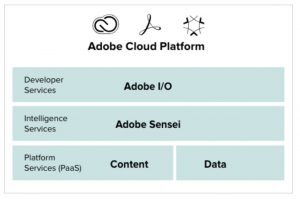How do we capture the essence of the Adobe Experience Cloud? This question is what Adobe’s Jim Rivera and Klaasjan Tukker, both directors of product management, looked to accomplish in a recent 2018 Adobe Summit session.
Where do we start?

High-level overview of the Adobe Cloud Platform.
Everything starts with the Adobe Cloud Platform (ACP): in short, this is where data is obtained, semantics applied and machine learning then transforms the data into actionable insights. Experience cloud is the place where the data is matched with the content service. This platform service is a layer under the Adobe Sensei layer that is where intelligence is derived from both content and data. The goal of ACP is designed to go beyond data from Adobe Solutions. It is designed to ingest, standardize and persist customer data from across your enterprise.
The starting point for the data process is Adobe Launch which is the Dynamic Tag Management software launched last year. Adobe Launch has now matured beyond a point solution into a platform, with 38 extensions and API endpoints. This allows developers to interact directly with Launch and extend the capabilities. With the release of Auditor, a free tool announced at 2108 Adobe Summit, there is no tooling that provides feedback on the quality of your Launch DTM implementation.
Next Steps
The next step is the need for disparate data to be able to communicate to each other. The solution for this issue is the introduction of the Experience Data Model (XDM). Since it’s introduction, there are now more than 50 schemes to create a common semantic definition. This is part of an open-source standards-based with extensible evolving within an ecosystem. The goal is to continue to grow with partners through open source.
Now that we have data from multiple sources, there is the need for data governance and addressing GDPR. Ultimately, with all this data sourcing and creating data, this requires the ability to enable consumers to control their own data. The platform provides the three means for delivery data governance.
- Labeling: classify the datasets appropriately based on your legal and corporate guidelines.
- Policy Framework: Create data policies to ensure that data is used in accordance to legal and corporate guidelines.
- Marketer Workflow: At the time of marketing action, data polices take effect providing feedback and guidance.
The Application
With these petabytes of data, the key is to apply Machine Learning to translate this into actionable insights. The goal is to open the ability to apply customer developed or open-source Machine Learning models within Platform.
There are three personas that Adobe Platforms is targeting to accelerate time-to-insights:
- Data Scientists-delivers custom insights
- Citizens Data Scientists-leverages pre-built models
- Marketers-leverages insights.
There are three machine learning-based services within the Platform ecosystem
- Ready-to use: Adobe developed model that require no training or configuration.
- 2. Configurable: Adobe developed a model that allow customer configuration and may require training.
- Custom: a model developed by a customer or partner
The newly announced Adobe Data Science Workspace is the place to derive these machine learning services.
End Goal
In the end, the goal of all of this activity is for driving the development and enrichment of the Unified Profile. This provides a view of the whole person. It creates a focus of consumer privacy and security, and is a single integrated segmentations experience.
Have you captured the essence of the Adobe Experience Cloud?
